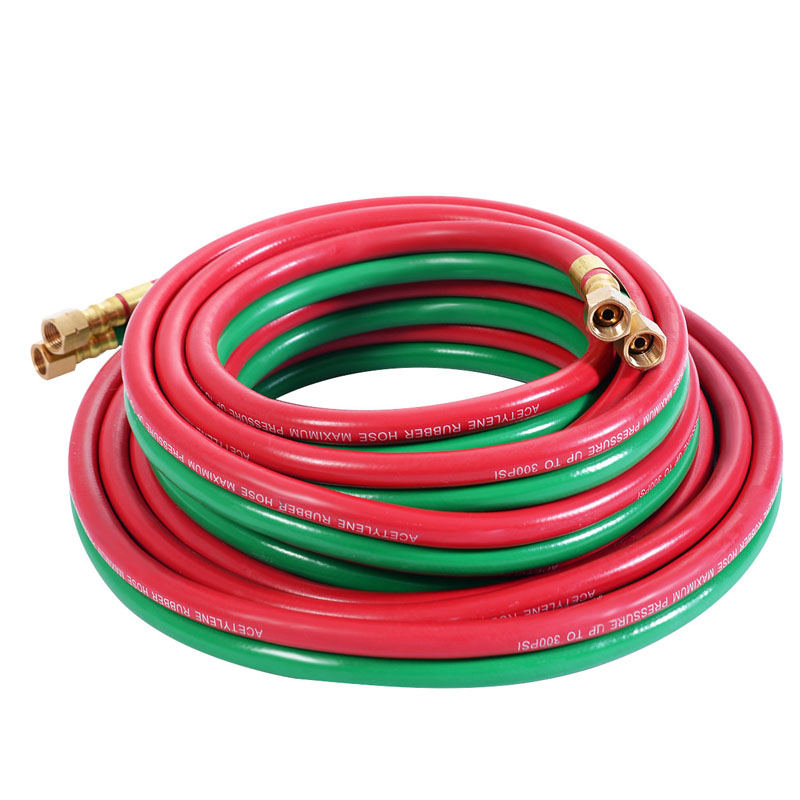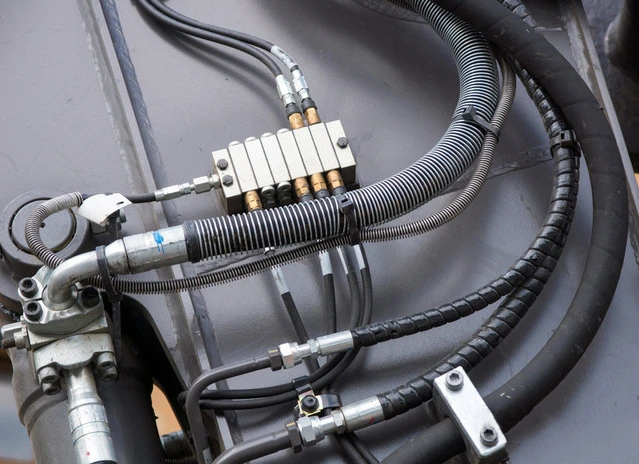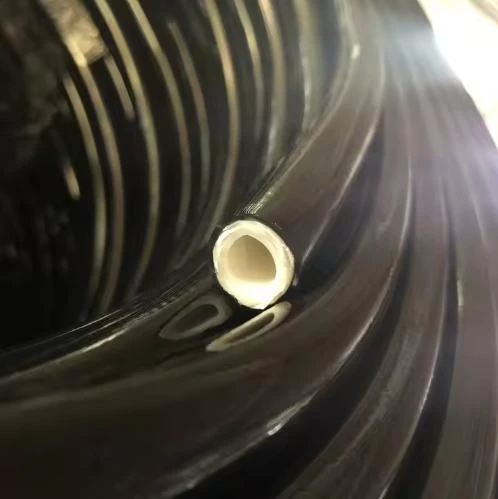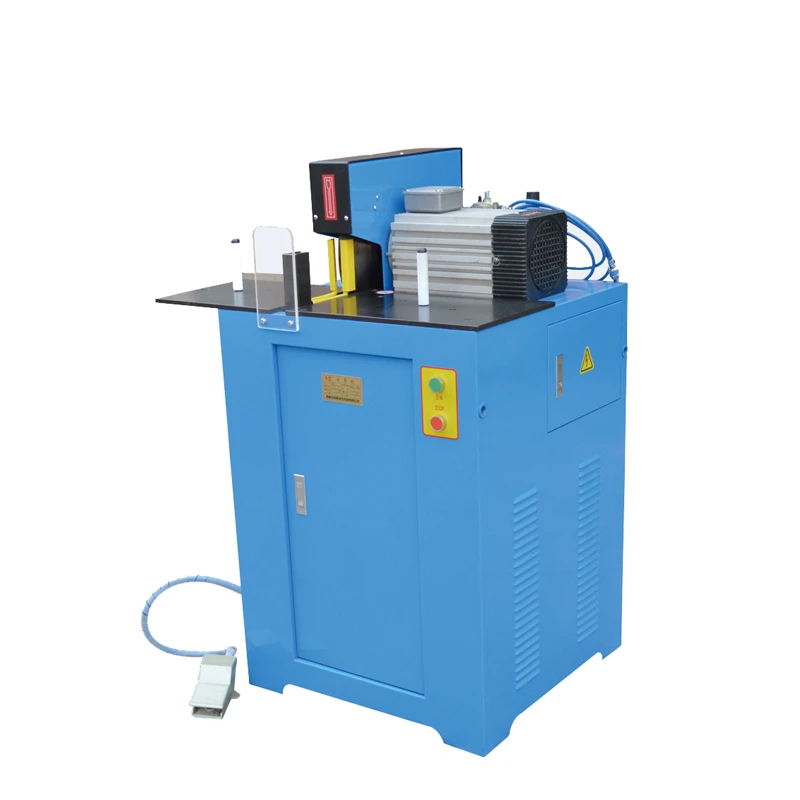Ống hàn
Ống hàn là loại ống mềm được thiết kế để vận chuyển an toàn các loại khí được sử dụng trong quá trình hàn, cắt và các quy trình công nghiệp khác. Các ống này được thiết kế riêng để xử lý môi trường áp suất cao và nhiệt độ cao, khiến chúng trở nên lý tưởng để sử dụng với các loại khí như oxy, axetilen, propan và các loại khí nhiên liệu khác được sử dụng trong các ứng dụng hàn. Cấu tạo của ống hàn thường bao gồm vật liệu cao su hoặc nhiệt dẻo bền, chống mài mòn, chịu nhiệt và tiếp xúc với hóa chất. Bên trong ống, thường có hai đường riêng biệt: một đường dành cho oxy và một đường dành cho khí nhiên liệu, đảm bảo chúng không bị trộn lẫn. Ống hàn thường được sử dụng trong các ngành công nghiệp như chế tạo kim loại, xây dựng, sửa chữa ô tô, đóng tàu và bảo dưỡng. Chúng rất quan trọng để cung cấp khí một cách an toàn cho mỏ hàn và dụng cụ cắt, cung cấp ngọn lửa cần thiết cho các nhiệm vụ như hàn đồng, hàn chì hoặc cắt kim loại bằng ngọn lửa. Các ống được thiết kế để ngăn ngừa rò rỉ, gấp khúc hoặc vỡ có thể gây ra tai nạn nguy hiểm trong quá trình sử dụng. Ống hàn có nhiều kích cỡ và chiều dài khác nhau để phù hợp với nhiều thiết lập hàn khác nhau và cấu trúc của chúng đảm bảo rằng chúng có thể chịu được áp suất và nhiệt độ cao thường thấy trong các hoạt động hàn. Với khả năng sử dụng kép và thiết kế chắc chắn, ống hàn đóng vai trò quan trọng trong việc đảm bảo an toàn, hiệu quả và hiệu suất trong gia công kim loại và các quy trình công nghiệp khác.
Những tính năng chính cần cân nhắc khi lựa chọn ống hàn là gì?
Khi lựa chọn ống hàn, cần cân nhắc một số đặc điểm chính để đảm bảo ống phù hợp với ứng dụng hàn cụ thể. Một trong những yếu tố quan trọng nhất là vật liệu của ống, vì ống cần bền và chịu được nhiệt, mài mòn và tiếp xúc với hóa chất. Hầu hết các ống hàn đều được làm từ vật liệu cao su hoặc nhiệt dẻo, có độ đàn hồi và khả năng chống mài mòn và rách trong khi vẫn giữ được tính toàn vẹn của chúng trong điều kiện nhiệt độ cao. Ống cũng phải có khả năng xử lý áp suất cao, vì khí hàn thường được lưu trữ và vận chuyển dưới áp suất đáng kể. Điều cần thiết là phải chọn ống có định mức áp suất phù hợp để tránh bị vỡ hoặc hỏng trong quá trình sử dụng. Ngoài ra, ống hàn thường được thiết kế với hai đường riêng biệt - một đường dẫn oxy và một đường dẫn khí nhiên liệu - đảm bảo rằng các khí vẫn tách biệt và không trộn lẫn, có thể dẫn đến các tình huống nguy hiểm. Vỏ ngoài của ống cũng phải chịu được các yếu tố bên ngoài như mài mòn, tia UV và điều kiện thời tiết, vì ống hàn thường được sử dụng trong môi trường ngoài trời. Chiều dài và đường kính của ống phải được lựa chọn dựa trên nhu cầu của quy trình hàn và khoảng cách giữa nguồn khí và địa điểm hàn. Hơn nữa, khả năng tương thích với các loại khí cụ thể đang được sử dụng là rất quan trọng. Ví dụ, ống mềm dùng cho dịch vụ oxy phải được đánh giá để sử dụng với oxy và không được chứa bất kỳ vật liệu nào có thể phản ứng với oxy, chẳng hạn như dầu hoặc mỡ. Cuối cùng, điều quan trọng là phải kiểm tra bất kỳ chứng nhận nào của ngành hoặc tuân thủ các tiêu chuẩn an toàn, chẳng hạn như các chứng nhận từ OSHA hoặc Hiệp hội Phòng cháy chữa cháy Quốc gia (NFPA), để đảm bảo ống mềm đáp ứng các tiêu chí an toàn bắt buộc cho các ứng dụng hàn.
Ống hàn nên được bảo dưỡng và cất giữ như thế nào để đảm bảo an toàn?
Việc bảo dưỡng và lưu trữ ống hàn đúng cách là điều cần thiết để đảm bảo an toàn và tuổi thọ trong quá trình sử dụng. Nên kiểm tra ống thường xuyên để xem có dấu hiệu hao mòn nào không, chẳng hạn như vết cắt, vết trầy xước, vết nứt hoặc rò rỉ, đặc biệt là gần các phụ kiện hoặc nơi ống tiếp xúc với các vật sắc nhọn hoặc bề mặt gồ ghề. Ống hàn cao su, một loại phổ biến trên thị trường, cũng phải chịu các cuộc kiểm tra này.
Nếu phát hiện bất kỳ hư hỏng nào ở ống hàn, cần phải thay thế ngay để tránh nguy cơ tiềm ẩn. Để ngăn ngừa hỏng ống, hãy đảm bảo ống được sử dụng trong giới hạn áp suất và nhiệt độ quy định, vì vượt quá các thông số này có thể dẫn đến vỡ. Sau mỗi lần sử dụng, điều cần thiết là phải bảo quản ống hàn đúng cách, bất kể chúng có phải từ nhà sản xuất ống hàn nổi tiếng hay không, ở nơi sạch sẽ, khô ráo, tránh xa ánh nắng trực tiếp, nhiệt độ khắc nghiệt hoặc hóa chất có thể làm hỏng vật liệu.
Kỹ thuật hàn ống đôi khi có thể ảnh hưởng đến tính toàn vẹn của ống, vì vậy điều quan trọng là phải chú ý đến những khía cạnh này trong quá trình kiểm tra. Việc cuộn ống lỏng lẻo là rất quan trọng để tránh bị gấp khúc hoặc uốn cong, vì uốn cong đột ngột có thể làm yếu ống và giảm tuổi thọ của ống. Khi cất giữ ống hàn, hãy đảm bảo chúng được treo hoặc đặt phẳng thay vì cuộn quá chặt.
Ngoài ra, ống hàn phải không có chất gây ô nhiễm, đặc biệt là dầu, mỡ hoặc các chất khác có thể phản ứng với khí được truyền, đặc biệt là trong ống oxy, nơi ngay cả một lượng nhỏ chất gây ô nhiễm cũng có thể tạo ra tình huống nguy hiểm. Nếu ống hàn phải tiếp xúc với việc sử dụng nặng nhọc hoặc môi trường khắc nghiệt, cần vệ sinh và bảo dưỡng thường xuyên để loại bỏ mọi chất gây ô nhiễm tích tụ.
Trước mỗi lần sử dụng, điều quan trọng là phải kiểm tra tất cả các phụ kiện và kết nối của ống hàn để đảm bảo chúng được gắn chặt và không bị rò rỉ. Sử dụng cuộn ống hoặc móc lưu trữ cũng có thể giúp sắp xếp ống và ngăn ngừa hư hỏng do rối hoặc mài mòn. Bằng cách tuân thủ các biện pháp bảo dưỡng và lưu trữ này, ống hàn sẽ duy trì được tính an toàn, độ tin cậy và hiệu suất, đảm bảo môi trường làm việc an toàn cho người vận hành.
Twin-line Structure and Safety Design Principles: Welding Hoses
SINOPULSE revolutionizes industrial safety through the engineering of twin welding hoses with a cutting-edge dual-chamber structure. Engineered for precision and reliability, our rubber twin welding hoses address the critical need for safe gas separation in high-risk welding and cutting operations, setting a new standard for performance and protection.
At the heart of SINOPULSE’s welding hoses lies a dual-channel architecture, featuring independent inner tubes dedicated to oxygen and combustible gases such as acetylene or propane. This physical separation is not merely a design choice but a safety imperative: by preventing the mixing of explosive gas combinations, it eliminates the risk of catastrophic ignition within the hose itself. The oxygen chamber, constructed from premium rubber compounds, adheres to strict non-oil and non-grease standards, ensuring compliance with oxygen service safety protocols. Meanwhile, the gas chamber is formulated to resist degradation from hydrocarbons, maintaining integrity even under prolonged exposure to aggressive fuel gases.
To fortify this innovative structure, SINOPULSE integrates multiple reinforcement and protection layers. A robust braided layer, typically composed of high-tensile synthetic fibers or stainless steel, wraps around each chamber, providing mechanical strength capable of withstanding working pressures of up to 20 bar and burst pressures exceeding 60 bar. This reinforcement prevents tube collapse or rupture, safeguarding against sudden failures that could endanger operators. The outer cover, crafted from abrasion-resistant rubber, acts as a shield against external threats: it repels sparks, resists flame penetration, and withstands mechanical impacts common in welding environments. Select models also incorporate anti-static properties, dissipating electrical charges to eliminate ignition risks posed by static buildup.
SINOPULSE’s commitment to safety extends beyond material and structural design. Our twin welding hoses adhere to international safety standards, ensuring seamless integration into industrial safety protocols. The dual-chamber design further optimizes performance by maintaining consistent gas flow rates, enabling welders to achieve precise control over flame temperature and cutting precision.
In metal fabrication, shipbuilding, and construction—industries where safety is paramount—SINOPULSE’s rubber twin welding hoses offer a reliable solution that combines advanced engineering with uncompromising protection. Trust in our hoses to deliver both safety and efficiency in every welding operation.
Selection Decision Tree for Welding Hoses by Gas Type
As a trusted welding hose manufacturer, SINOPULSE understands that selecting the right hose depends on the specific gas used in your welding or cutting application. Different gases—oxygen, acetylene, propane, or inert gases like argon—have unique chemical and physical properties, requiring tailored hose designs to ensure safety, efficiency, and compliance. Below is a structured guide to help you choose the ideal twin welding hose or single-line solution for your needs.
1. Oxygen (O₂) Hoses: Prioritize Purity and Non-Reactivity
Oxygen hoses transport compressed oxygen to fuel the welding flame, making material compatibility critical. SINOPULSE’s rubber twin welding hoses for oxygen feature:
Non-Oil, Non-Grease Inner Tubes: Constructed from premium EPDM or neoprene rubber to prevent hydrocarbon contamination, which can cause explosive reactions with pure oxygen.
Flame-Resistant Outer Covers: Engineered to withstand sparks and radiant heat, reducing fire risks in high-temperature work environments.
Pressure Ratings: Working pressures up to 20 bar (290 PSI) to meet standard oxygen service requirements, with burst pressures exceeding 60 bar (870 PSI) for safety redundancy.
2. Acetylene (C₂H₂) Hoses: Resist Hydrocarbon Degradation
Acetylene, a highly flammable gas, requires hoses that can withstand its reactive nature and low working pressures (typically ≤1 bar). Key selection criteria for SINOPULSE acetylene hoses include:
Hydrocarbon-Resistant Compounds: Inner tubes made from butyl rubber or chloroprene to prevent swelling or cracking caused by acetylene exposure.
Anti-Static Properties: Optional conductive layers to dissipate static charges, a critical safety feature for preventing ignition in volatile environments.
Color Coding: Mandatory red outer covers for easy identification, aligning with international safety standards for acetylene lines.
Flexibility in Low Temperatures: Maintains pliability down to -20°C, ensuring reliable performance in cold climates or outdoor welding.
3. Propane (C₃H₈) and Natural Gas Hoses: Balance Pressure and Flexibility
Used in cutting and heating applications, propane hoses must handle moderate pressures (up to 5 bar) while resisting cold brittleness. SINOPULSE solutions offer:
Low-temperature Resistant Formula: Specialized thermoplastic rubber (TPR) inner tubes that remain flexible at -40°C, ideal for construction or agricultural welding in frigid conditions.
Abrasion-Resistant Outer Layers: Thickened rubber covers to withstand rough handling on job sites, where hoses may drag over gravel, metal, or concrete.
Leak-Proof Fittings: Compatibility with propane-specific connectors to minimize gas loss and ensure secure connections during high-demand operations.
4. Inert Gases (Argon, Helium): Ensure Purity for TIG/WIG Welding
For TIG (Tungsten Inert Gas) welding, where gas purity is essential for weld quality, SINOPULSE recommends:
High-Purity Inner Tubes: Smooth-bore polyethylene or silicone liners that prevent gas contamination, critical for welding stainless steel or aluminum.
Low Permeability Design: Multi-layer construction to minimize gas diffusion, ensuring consistent shielding gas flow and reducing porosity in welds.
Lightweight Construction: Braided synthetic fiber reinforcement for easy maneuverability during precision welding tasks that require fine control.
Key Decision Factors Across All Gases
Gas Compatibility: Always verify that the hose’s inner tube material is rated for your specific gas (e.g., acetylene requires non-copper alloys in fittings to avoid acetylide formation).
Pressure vs. Temperature: Match the hose’s working pressure (e.g., low-pressure acetylene vs. high-pressure oxygen) and temperature range (-40°C to +80°C for most models).
Environmental Hazards: Choose anti-UV covers for outdoor use, spark-resistant layers for proximity to welding arcs, or chemical-resistant coatings for industrial environments with corrosive agents.
Dual vs. Single Chamber: Twin welding hoses are ideal for oxy-fuel setups requiring parallel oxygen and gas lines, while single-line hoses suit inert gas or standalone fuel systems.
Trust SINOPULSE for Tailored Solutions
With decades of expertise in welding hose engineering, SINOPULSE offers a comprehensive range of rubber twin welding hoses and single-line products, each designed to meet the unique demands of your gas type and application. Our team can help you navigate certifications, material specifications, and custom fittings to ensure your welding system operates safely and efficiently.
Contact us today to discuss how our precision-engineered hoses can elevate your welding operations.












